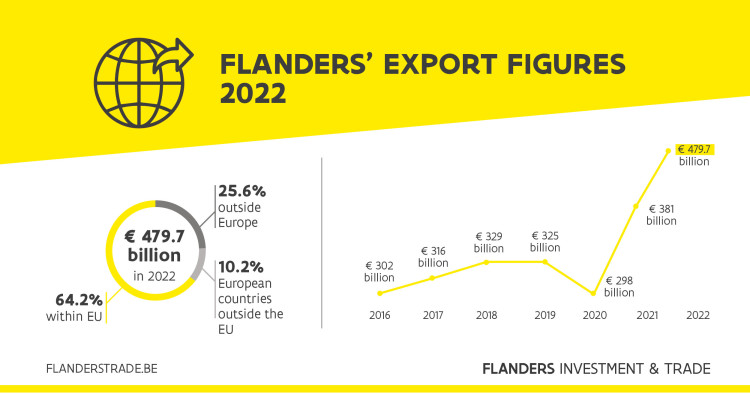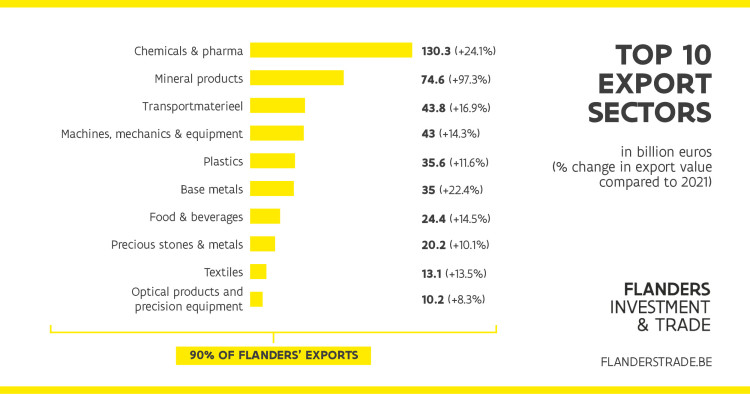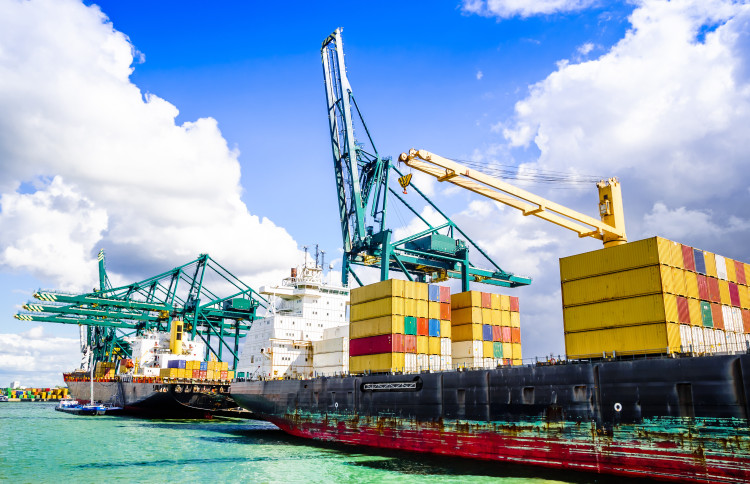Flanders export figures 2022: goods exports up 26%, but growth has slowed since Q4
At 479.7 billion euros, the value of goods exports from Flanders was exceptionally high in 2022. The total export value was more than a quarter higher (+26%) than in 2021, 61% higher than in 2020 and 47.7% higher than in 2019, the pre-pandemic year. According to a FIT analysis based on data from INR/NBB, this increase was mainly driven by rising world prices. From the last quarter onward, growth slowed down due to declining energy and flattening commodity prices.
Flanders' goods exports amounted to 479.7 billion euros, a 26% increase on 2021. According to INR/NBB, about three quarters of this increase can be attributed to the surge in world prices. Since they became 'normal' again from the 4th quarter, exports from Flanders have clearly shown signs of a slowdown.
The value of exports is growing at the pace of the EU (+20.9%) and the global average (+25.2%). In 2022, Flanders held a strong 16th position as a world goods exporter.
Most of the increased export value (62.7%) can be attributed to 2 sectors: mineral products (soaring oil and gas prices) and chemicals & pharmaceuticals (export of COVID-19 vaccines and medicines).
Nearly two thirds (64.2%) of Flanders exports were destined for EU member states, while 10.2% went to European countries outside the EU.
In addition to intra-Community trade (+25.2%), exports to other continents also registered growth (+27.6%), with the US taking the lion's share (+40.4%).

1. Export value driven by energy prices and COVID-19 vaccines
The strong increase in the export value is partly due to the economic recovery in the wake of the COVID-19 pandemic in 2020 and 2021. Much more than higher volumes, however, the sharp rise in world prices was a determining factor in the strong export value of our region in 2022. INR/NBB states that no less than three quarters of the value increase in Flanders imports and exports can be attributed to this trend. From agricultural commodities to energy and precious metals, many of our export products require raw materials whose world prices peaked – especially in March and April 2022.
Since August 2022, energy prices have gone back to 'normal'. Combined with the smaller role played by COVID-19 vaccines in exports, this had the effect of slowing down the growth of Flanders' exports value in the last quarter. This weaker growth is maintained into early 2023.

2. Flanders is growing at the pace of European and world trade
Flanders' export value (+26%) rose faster than the EU average (+20.9%). Flanders also outperformed competitors Germany (+13.7%), Italy (19.9%), France (+18.6%), Spain (+23.7%), Poland (+19%), Czech Republic (+19.8%), Austria (+17.2%) and Sweden (+17.2%). Only the Netherlands (+29.3%) and Ireland (+26.1%) came out stronger within the EU.
Moreover, the increase in the Flanders export value is in line with world trade growth (+25.2% in euros) (source: FIT analysis based on WTO data). We thus achieved a strong 16th position as a world goods exporter with a share of 2.03% of global exports (source: FIT analysis based on WTO ranking). Our region achieved a 79.4% share of overall Belgian exports.

3. Energy and pharma account for two-thirds of increased export value
While, in 2022, all 22 of Flanders export sectors made a profit, mineral products and chemicals & pharmaceuticals together accounted for almost 63% of the export value increase. The export value of mineral products – our 2nd export sector – doubled (+97.3%) due to exploding energy prices. The Port of Zeebrugge (PoAB) plays a crucial role in this sector as an important import and export hub for natural gas within Europe.
In chemicals & pharmaceuticals, Flanders' top export sector with a 27.2% share, the export value rose by 24.1%. For the energy-intensive chemical sector, this is due to the high cost of oil, while COVID vaccines were the driving force in the pharmaceutical industry. For the second year in a row, these vaccines were our top export product in 2022, accounting for 6.03% of all Flanders exports. The fact that another 11% more COVID vaccines were produced in 2022 than in 2021 is a notable trend.
Transport equipment – our 3rd export sector – partially recovered in 2022 (+17.4%) after a severe downturn (-67%) in 2021 due to Brexit and global parts shortages. Machinery, mechanics and equipment and the plastics sector complete the top five export sectors, growing by 14.3% and 11.6% respectively compared to 2021.
Other traditionally important export sectors also experienced growth, such as food & beverages (7th export sector) up 14.5% and textiles (9th export sector) up 13.5%. Within the textile sector, carpet was one of the few exports to experience a slight decline (-3.9%) in 2022.
4. Two thirds of export goods remain within the EU
EU states received 64.2% of exports from Flanders, which is fully consistent with previous years (64.5% in 2021). Exports to the Netherlands (2nd export market) increased by 49.9% (24.6 billion euros more) thanks to sharp increases in fuels (+62.6%), organic chemicals (+27.6%) and iron and steel (+38.1%). Out of all export markets, exports to the Netherlands experienced the strongest growth. Comparatively, export growth to Germany (1st export market) was limited to +18% and to France (3rd export market) to +20.4%.
The European markets outside the EU accounted for 10.2% of exports from Flanders in 2022. The UK (4th export market) registered a 17.7% increase, or 4.2 billion euros more. In addition, exports to Switzerland (+30.0%) and Turkey (+18.9%) experienced particularly strong growth.

5. Exports to other continents also on the rise
More than a quarter (25.6%) of exports from Flanders went to other continents. Exports demonstrated strong growth in North America (+35.8%), Central America (+72.3%), South America (+47.9%), Asia (+18.7%), the Middle East (+15.9%), and Africa (+57%). Only exports to Oceania (-12.4%) decreased due to a drop in demand for COVID vaccines. Driven by pharmaceuticals and (COVID) vaccines, exports to the US (5th export market) experienced a strong boost (+40.4% or 7.9 billion euros more than in 2021).
Among the top 50 export markets for Flanders goods, only four experienced a decline – all non-EU countries: China (12th export market), Russia (25th), Australia (36th) and Egypt (39th). Exports to China experienced an exceptional decrease (-4.93%) for wood, trucks, zinc and diamond, among other goods. In absolute terms, this was the third strongest decline worldwide after Russia and Egypt. Lower demand for COVID-19 vaccines can be attributed to the drop in exports to Australia (-10.5%).
Partly due to the sanctions, goods exports to Russia fell by 18.1%. If we remove from the equation the large supplies of medicines to Russia, exports to Russia fell by 50%. Given its limited share of total exports from Flanders (25th export market), this decline had hardly any impact on overall export trends. The same applies to Ukraine (70th export market), to which exports of mainly agricultural machinery and equipment fell by 35%. These are traditionally the most important export goods that leave Flanders for Ukraine.
“Exports from Flanders have made up for the backlog caused by the COVID-19 pandemic. Even more so than the export volumes, the high energy prices caused the export value to rise sharply. This price effect then leveled off from the third quarter of 2022. In January 2023, the Flanders export value only rose by 5%, according to the first figures released by INR/NBB. This slowdown in export growth is expected to continue in 2023, also at a global level. In the given circumstances, the business-strengthening services provided by FIT will become more important than ever.” – Joy Donné, CEO of Flanders Investment & Trade (FIT)
“Export is the trademark of Flanders: in 2022 we secured a strong 16th position among world goods exporters. This means that 1/50th of everything that is exported worldwide comes from or is traded through Flanders. This is an exceptionally strong performance for such a small region. As one of the most open economies in the world, international business is our lifeblood, with a significant impact on job creation and prosperity.” – Minister-President of the Government of Flanders Jan Jambon

